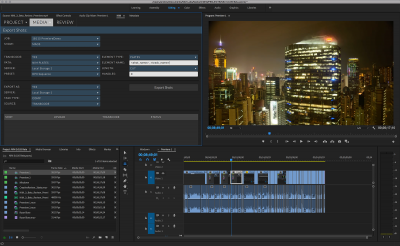
NIM is a studio management solution, spun out from an in house team at LA post facility Ntropic. NIM is intended to provide effective ways to measure and visualize production studio workflows, from production planning to project management through to full real time financial analysis.
It is a unique solution as it is very much designed to track financial information alongside project progress. This enables deep business intelligence for creative studios both large and small. This is both critical and one of the most over looked aspects of successful VFX production.
In a world where the tools are increasingly open source and team members are fluid to move between projects, the most critical aspect to long term success is managing your VFX business. But in saying that, one needs to define success. People are quick to think ‘success’ is profit, especially when talking about project management software. But both Ntropic and the NIM Labs think of success in it’s correct incarnation: success for all stakeholders. This is not just hype. The team firmly believe if you can have staff who are not frustrated by pointless wasted work or rework, if you can have clients whose expectations are not only matched but exceeded, if you can balance project workflow to avoid burning out your staff, and give your artists and your producers time to be creative and innovative, and make a profit – you have the secret to long term sustainable success.
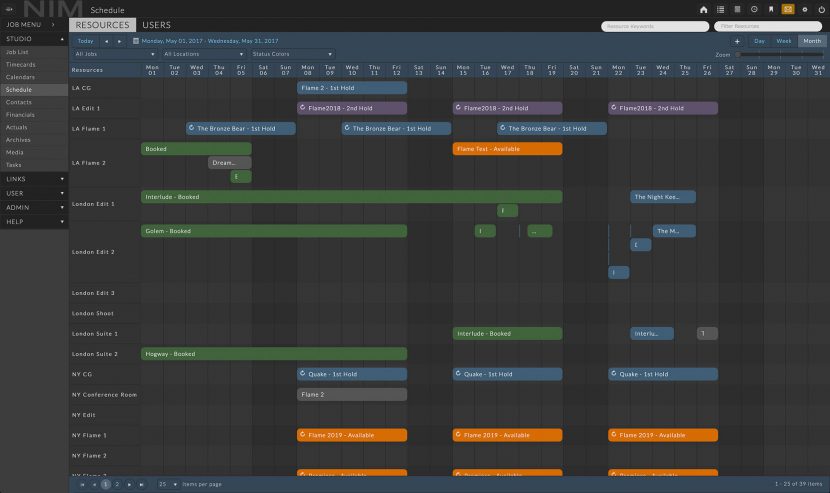
NIM 3.0 and Adobe
A new version of the team’s NIM software has just been released. NIM Labs’ latest version is NIM 3.0, and in it, the team redesigned its shot review toolset and added new customisable templates for bidding on jobs. It also improves a range of functions and extends the product to cover even more industry applications.
After years of building NIM Connectors into Maya, Houdini, 3ds Max, Nuke and Flame, NIM Labs now also has a direct workflow for Adobe Premiere. This is NIM’s third Adobe product connection, following After Effects and Photoshop. With the October NIM 3.0 release, Premiere is integrated to work as a powerful conform tool and effects editor. Editors can do everything from creating timeline shots to round-tripping elements rendered in other packages, all without leaving the App. Due to the v3.0 NIM Connector, the creative review process can be conducted from within Premiere, creating a seamless experience that saves time.
NIM 3.0 is now shipping, with pricing starting from $40/month or $360/year. NIM is delivered as a preconfigured Ubuntu Server virtual appliance. A virtual appliance (VA) is a virtual machine (VM) image file consisting of a pre-configured operating system environment and a single application. The purpose of a virtual appliance is to simplify delivery and operation of an application. Users can use virtualisation tools like VirtualBox or vSphere to run the virtual machine on Windows, other flavours of Linux, and Mac OS X.
The new software shipped a couple of weeks ago, but we caught up with the team just prior to its release.
Want to make a difference to your next project? Look back
One of the most powerful and yet hated parts of being in a VFX team is looking back and comparing your estimates with the eventual actuals. Everyone in production can easily feel like this process is designed to humiliate them. But if you visit the world’s top VFX teams one can quickly see that the postmortem process is seen as more than just an exercise, it is seen as a critical component of enduring success. NIM is designed to make this process as positive and constructive as possible.
There is a wealth of research to underline how quick we are to walk away from project tasks such as Postmortems. From behavioural economics to psychology, there is research that proves we underestimate problems, amplify losses, fail to plan for contingencies and, most of all, we seem to pathologically not want to learn from our mistakes and change our behaviour. Who amongst us cannot testify to only wanting to review the ‘good jobs’, the ones that went well. We desperately want to forget the bad ones and never speak of them again. This is why NIM’s background of coming from an actual working successful studio is so important. NIM reflects the DNA of successful Studio management at Ntropic.
Ntropic, in their own internal reviews, use their NIM software to find three key things or issues when reviewing a past project. “We try to find and then resolve just three things. You may not fix all your problems, but at least we can figure out what happened, and what those three core pillars were on any job. These things can be either obstacles or successes, – but figuring out what those three lessons, is what we use as a stepping stone to doing a better job on the next project,” says Andrew Sinagra, co-founder at NIM Labs and Creative Director.
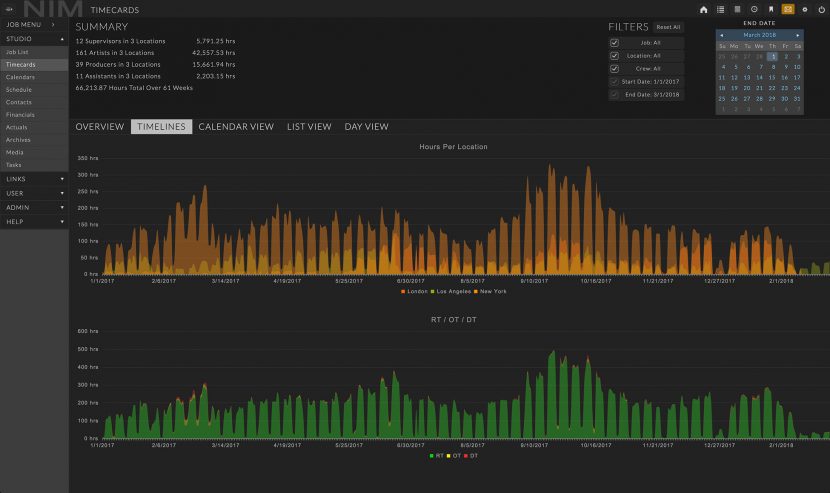
Ntropic
NIM Labs was formed as a separate unit inside Ntropic in 2014. Today it is a separate company. Ntropic itself has been around for much longer.
Nathan Robinson is the co-founder of Ntropic and he started as a filmmaker at the age of 15. By 18, Robinson had garnered an Emmy nomination and multiple awards for a documentary on the Beastie Boys, “The World Isn’t Listening.” In the same year, at the ripe old age of 18, Robinson co-founded Ntropic. The company would expand from San Francisco to Los Angeles in 2004, and then to New York in 2011. Today, Robinson is Executive Creative Director, owner, technical expert and even still, on some jobs, a VFX artist. He believes that the company brings “a very visual focus to everything” that they do.
The team at Ntropic have a wide range of top credits including advertisement campaigns for Nike, Apple, Franklin Templeton, Visa, Electronic Arts, Mercedes, Audi, Lincoln, Ford, Bulgari, and Louis Vuitton; music videos for Rihanna, Justin Timberlake and Green Day; visual effects for major motion pictures including Matrix, Underworld, and Live Free or Die Hard; and a range of TV Episodic work. It is this weight of production that drives their design thinking in project and studio management. Today, Ntropics’ NIM Labs’ software is used by companies such as Arsenal Creative, Digital Domain, Ayzenberg, Taylor James and Intelligent Creatures.
“We developed NIM because there was nothing like it on the market,” Sinagra comments looking back to when the product was first conceived. “We continued to build out the feature sets, incorporating requests from people across the studio landscape, to ensure that every part of the organization has what they need to do their job. Whether you are an artist whiteboarding shots for review or a producer determining how many freelancers you can hire and still stay profitable, it’s all there.”

Old School
It is stunning how many companies try and run modern cutting edge visual effects projects from an excel spreadsheet. The NIM software was developed to provide a way to run a company in a very visual way. Excel is a great spreadsheet, but when it comes to Project Management, it is not designed for the task. NIM Labs seek to go further than just produce a project management tool, they see NIM as being Studio Management. Their view is that it works by providing management for multiple projects, in multiple locations, in more creative ways.
The team notes that the company is very visual and as such they want the running of their projects to be just as strong conceptually and visually. “Hopefully a lot of it seems like common sense. The way the UI has been designed, the workflows – it gives you all the information right there. It’s real time and that’s our goal,” explains Sinagra.
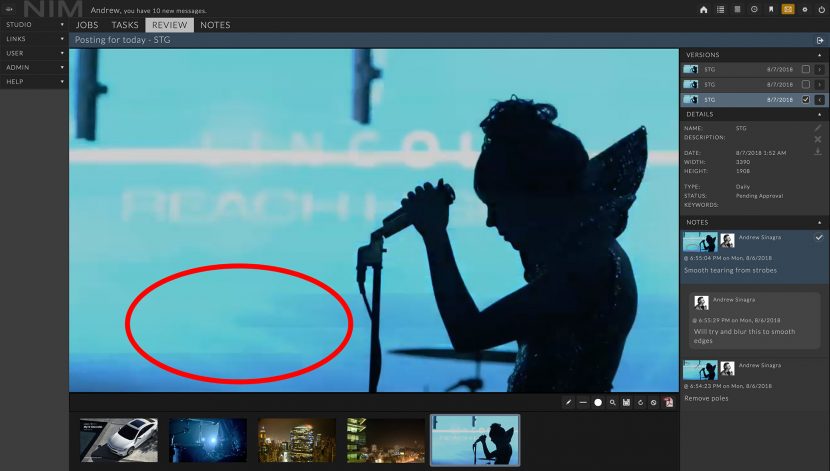
Scheduling the daily work of the 90% of the team who are doing the actual work is, of course, important. But NIM Labs also wants to service the smaller but critical team that is the producers, the schedulers, the coordinators, the finance team & the owners, and the sequence and line producers. Having the creative team organised and informed should not mean losing sight of this smaller group who hold significant accountability and “who need to be able to learn from what they’re doing rather than just making the same mistakes and tripping on their shoes repeatedly,” points out Sinagra. NIM seeks to allow dynamic, current and on going windows into the company as a whole.
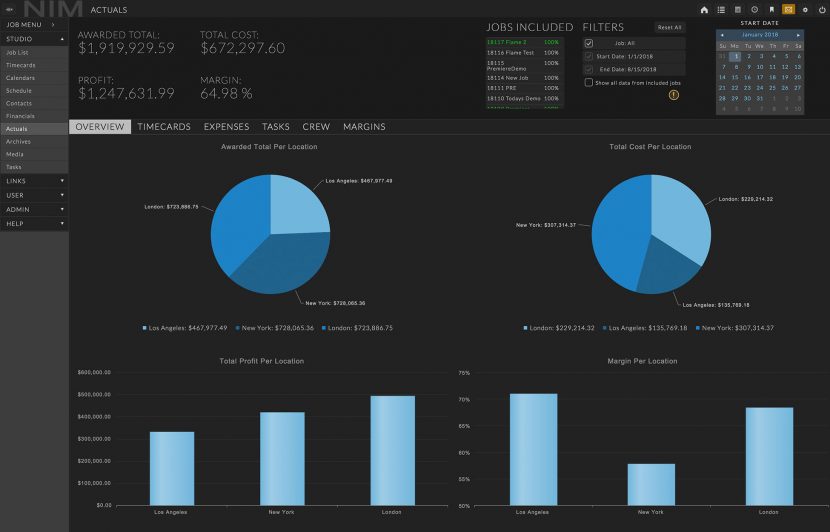
As part of this release in v3.1, the bidding system will be further extended. It will provide the option to define different sections of a bid using groups, providing more flexibility when bidding for large jobs. Bidding will support item linking, enabling users to modify multiple line items simultaneously, with the ability to attach supporting images, notes and descriptions.
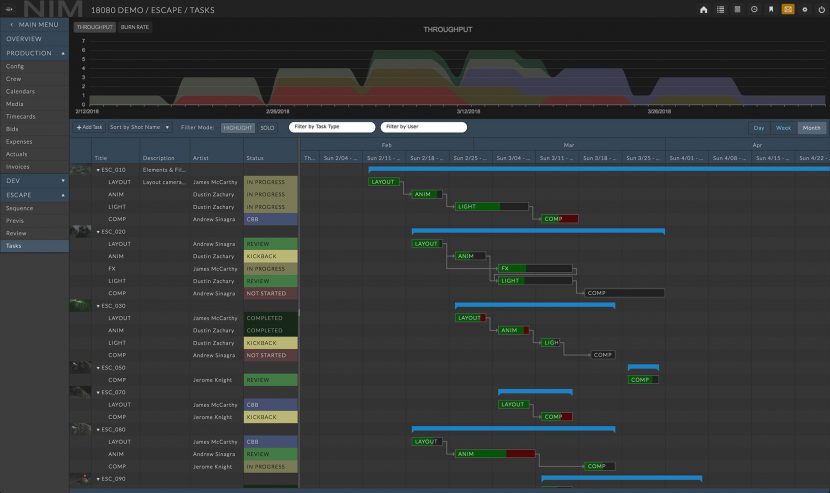
Adaptive process
The nature of visual effects work is an evolution of ideas. To change and improve a shot is not ‘a mistake’. Revisions aren’t always the client changing their mind, it is more often an exploration. It is the process of refinement and finding what tells the story. By its very nature, VFX work is pushing the boundaries and inventing new techniques. Clients want innovation and experimentation. If one starts with the assumption that change is natural, and to be embraced, then you run your entire company slightly differently.

“Working as a supervisor, task estimation is like your best guest, right?” comments Sinagra. People estimate based on their own personal history, their knowledge of what they have done before and the particular client’s history of decision making and style. “For example, here’s what I think this modelling task will be and then this lighting task is going to take this time, etc. You breakdown the script.” But Sinagra points out that there will always be the need to shift and pivot throughout the course of the job and you can only respond to those client changes properly, if you have the facts. And then you take the time to reevaluate. “You need the proper information to reevaluate successfully, then efficiently and easily reschedule. I think a lot of problems come from people not being willing to take a step back. They can’t reschedule fully because they don’t have the right information and the process, itself, just takes too much time.” NIM labs therefore builds their tools assuming change and the need for immediate and easy course corrections. Changes made early are always vastly cheaper than those made late or that are just reactionary moves in a crisis.
NIM Labs supports traditional models of studio management and project management such as Gantt charts, calendars and work break down structures but the team are also keen to provide adaptive tools that work in the real world, built on practical informed decisions.
Key to adaptive approaches is having the planning at a granular enough level. If a task is just a lump of work labelled with a one month schedule estimate, the process can not be nimble and responsive. But while it is easy to preach breaking down the project into much smaller tasks, if the software for doing that is cumbersome, it acts as a disincentive and the process fails. If it is hard to adequately breakdown the script then the cost of doing the breakdowns or bidding, then itself becomes an issue. “And I’d say that’s where NIM shines – it helps you to put in that time up front and get a detailed breakdown with the best case knowledge of your historical understandings,” Sinagra explains.
Studio view
In the real world, a Studio is rarely managing just one project, but a collection of projects. In formal terms, this is called Portfolio management, but NIM Labs refers to it as Studio Management.
Sinagra explains that, in his opinion, “one of the core aspects of NIM, is a historical perspective. We want to tell the story of your studio. At any point in time you can go back and look at your bids, your actuals, how you’re tracking your finances – all at a studio wide level. We do year progressions and we’re multi location aware. So, for example, you can see where the bulk of your work is being distributed across your studios and where those spikes are. You can see how that time split out in terms of say regular time, overtime and double time, at each location and over time”. In addition to day to day reporting, NIM seeks to provide a studio view at a high level . To form a clear view of the company’s overall health. The NIM software is designed to allow managing jobs in realtime, rather than dealing with the consequences of problems after the fact.
Global
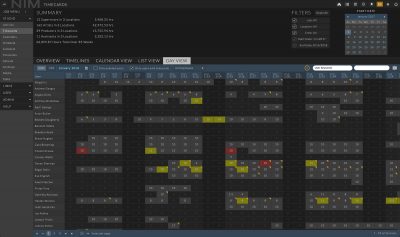
Additionally, NIM works well when a studios multiple offices are in different countries. Currency fluctuations, along with naturally different labour costs, all make global bidding complex. While some companies hedge their currencies or operate in just one currency (often USD), NIM aims to be flexible. Each job can have its own currency and bids can have their own currency. Even crew members can have their own currency, allowing for freelancers working remotely into an office not in the same country.
Digital Domain is a NIM Lab’s client. They recently decided to extend their use of NIM into their feature film work. “Feature bidding has all of its own challenges,” explained Sinagra. “We met with them and they want to have each line item have its own individual exchange rate. So if someone is doing roto in China and say, compositing in Canada, they want to be able to see that compounded within a single shot on a bid. But then also be able to split that out into three separate bids and verticals and present those to the client. So that’s one of the things that we’re working on tackling as we speak.”
Culture
Brian McClure, Head of Sales and Marketing at NIM points out that the way NIM is designed and used is not as a top down ‘management tool’ to control people. “If the culture of the company is to inform from the bottom up, instead of the top down, then you’re going to have a really cohesive work environment. In that way everyone is going to feel that they’re heard, that their input is validated and in the end, I think that is how you get those very positive postmortems we discussed earlier,” he explains. The ability to have ownership of work, not just creatively and also in terms of bidding and tracking, is key. It empowers artists and producers alike to be more involved. This, in turn, leads to a more complete and accurate studio management system.
NIM Labs does not seek to exclude the role of the artist in the successful running of the business. Ntropic prides itself on seeking artist engagement and then trusting the person doing the work. Sinagra points out that a supervisor’s relationship to their team is not unlike the relationship between the client and the effects studio, “as I used to say when I was a visual effects supervisor to our clients, ‘you hired us because you trust us to do a good job’. It is the same in how you should treat your employees. If I hire an artist, I should have that same respect for them. I made that decision to bring them in. I should trust them with the work that they’re doing.”
The NIM team hopes that their dedicated Studio management software can aid in that respectful coordination of the team to build long term studio success.
